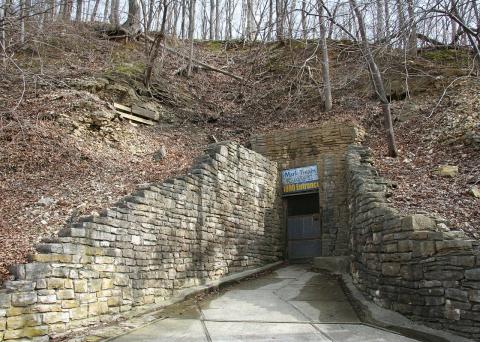Mark Twain Cave — originally McDowell's Cave — is a show cave located near Hannibal, Missouri. It was named for author Mark Twain whose real name was Samuel Langhorne Clemens. Clemens lived in Hannibal from 1839 to 1853, age 4 to 17. It is the oldest operating show cave in the state, giving tours continuously since 1886. Along with nearby Cameron Cave, it became a registered National Natural Landmark in 1972, with a citation reading "Exceptionally good examples of the maze type of cavern development." The cave — as "McDougal's Cave" — plays an important role in the novel The Adventures of Tom Sawyer (1876) by Mark Twain and was renamed in honor of the author in 1880.
The Life of Mark Twain: The Early Years, 1835-1871, pp 57-8
Explored in 1819 by a hunter named Jack Simms and located some two miles downriver from Bear Creek, the limestone labyrinth was called Simms’s Cave or Saltpeter Cave by the whites in the region before it was purchased by Dr. Joseph Nash McDowell—a rabid Southerner, prominent St. Louis physician, and founder of the first medical school in the city—and renamed McDowell's Cave. While privately owned, it was open to the public until late 1845, when McDowell sealed it with an iron or oaken door so that he could stockpile munitions, either to support an American military invasion of Mexico or to repel a Mexican invasion of the American Southwest…
McDowell unbarred the door and again opened it to visitors—with a twist. He permitted a relative, Dr. E. D. McDowell, to install a sarcophagus, a copper cylinder filled with alcohol containing the body of his fourteen-year- old daughter, in the cave. He believed the body would eventually mummify like the bodies of several Indians who had been found in the saltpeter caves of Kentucky. But as Sam explained in Life on the Mississippi, “The top of the cylinder was removable; and it was said to be a common thing for the baser order of tourists to drag the dead face into view and examine it and comment upon it.“° Given the threat of vandalism, McDowell was compelled to remove and bury the body after only three or four years. Over the next decade, the cave reportedly sheltered escaped slaves on the Underground Railroad, and when the Civil War erupted McDowell may have again cached weapons there for the Confederate Army. At the end of the century, Jesse James may have used it as a hideout.
But in the late 1840s the “great Missouri labyrinth” was a favorite recreation site for local residents. Both Laura Hawkins and Orion in his final Lorio letter to the St. Louis Reveille mention picnics there. “Usually my elder sister” and Sam’s sister Pamela, Laura recalled, accompanied them “to see that we didn’t get lost among the winding passages where our candles lighted up the great stalagmites and stalactites, and where water was dripping from the stone roof overhead.” The boys in town also used it as a hideout, though at the time it had been only partially mapped and some erstwhile explorers, according to local legend, had starved to death in its depths. Orion speculated in 1847 that it was “at least eight or ten square miles” in extent. In 1852, in one of the first pieces he wrote for publication outside Hannibal, Sam reported that the cave was “of unknown length; it has innumerable passages, which are not unlike the streets of a large city. The ceiling arches over, and from it hang beautiful stalactites, which sparkle in the light of the torches, and remind one of the fairy palaces spoken of in the Arabian Nights. There are several springs, rivers, and wells, some of which are of unknown depth.”
